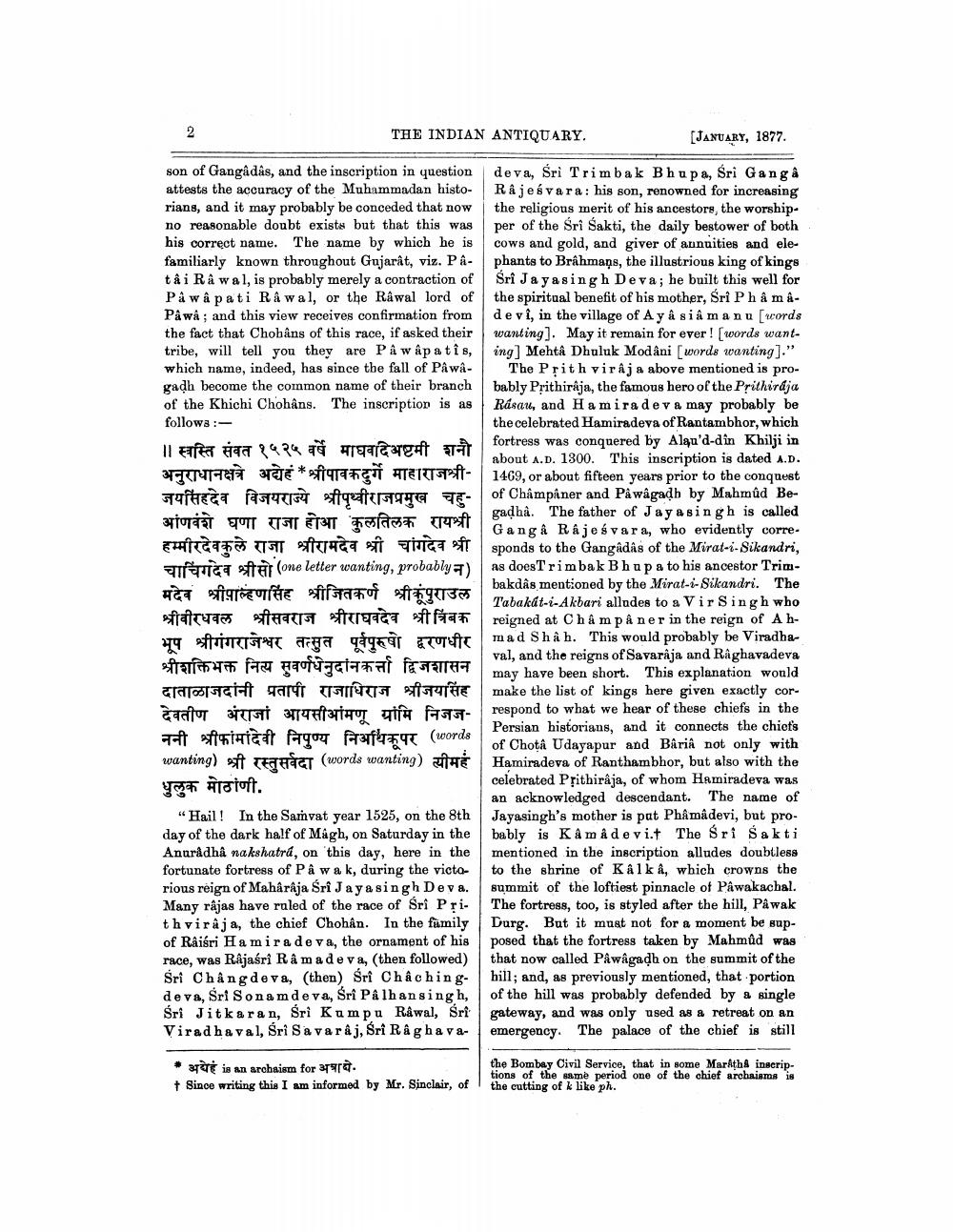Book Title: Indian Antiquary Vol 06 Author(s): Jas Burgess Publisher: Swati Publications View full book textPage 6
________________ 2 THE INDIAN ANTIQUARY. son of Gangâdâs, and the inscription in question attests the accuracy of the Muhammadan historians, and it may probably be conceded that now no reasonable doubt exists but that this was his correct name. The name by which he is familiarly known throughout Gujarât, viz. Pâtâi Rawal, is probably merely a contraction of Pawâ pati Rawal, or the Rawal lord of Påwå; and this view receives confirmation from the fact that Chohâns of this race, if asked their tribe, will tell you they are Pâ w âpa tis, which name, indeed, has since the fall of Pâwâgadh become the common name of their branch of the Khichi Chohâns. The inscription is as follows: ।। स्वस्ति संवत १५२५ वर्षे माघवदिअष्टमी शनौ अनुराधा नक्षत्रे अद्येहं * श्रीपावकदुर्गे माहाराजश्रीजयसिंहदेव विजयराज्ये श्रीपृथ्वीराजप्रमुख चहुआंणवंशे घणा राजा होआ कुलतिलक रायश्री हम्मीरदेवकुले राजा श्रीरामदेव श्री चांगदेव श्री (one letter wanting, probably) मदेव श्रीपाहणसिंह श्रीजितकर्ण श्रीकूंपुराउल श्रीवीरधवल श्रीसवराज श्रीराघवदेव श्री त्रिंबक भूप श्रीगंगराजेश्वर तत्सुत पूर्वपुरुषो द्वरणधीर श्रीशक्तिभक्त नित्य सुवर्णधेनुदानकर्त्ता द्विजशासन दाताळाजदांनी प्रतापी राजाधिराज श्रीजयसिंह देवतीण अंराजां आयसीआंमणू ग्रांमि निजजननी श्रीफांमदिनी निपुण्य निधिकूपर (conda wanting) (words wanting) धुलुक मोठांणी "Hail! In the Samvat year 1525, on the 8th day of the dark half of Magh, on Saturday in the Anuradha nakshatra, on this day, here in the fortunate fortress of P â wa k, during the victorious reign of Mahârâja Śri Jayasingh Deva. Many râjas have ruled of the race of Sri Prithviraja, the chief Chohân. In the family of Râiśri Ha mira deva, the ornament of his race, was Rajasri Râ made va, (then followed) Sri Changdeva, (then) Śrî Châchingdeva, Śri Sonamdeva, Śri Pâ lhansingh, Śri Jitkaran, Śri Kumpu Râwal, Śri Viradhaval, Śri Savaraj, Śri Raghava अहं is an arohnism for अत्राये. † Since writing this I am informed by Mr. Sinclair, of [JANUARY, 1877. deva, Śri Trimbak Bhupa, Sri Ganga Râjesvara: his son, renowned for increasing the religious merit of his ancestors, the worshipper of the Śri Sakti, the daily bestower of both cows and gold, and giver of annuities and elephants to Brahmans, the illustrious king of kings Sri Jayasingh Deva; he built this well for the spiritual benefit of his mother, Śrî P h â mâdevi, in the village of A y â siâ manu [words wanting]. May it remain for ever! [words wanting] Mehta Dhuluk Modâni [words wanting]." The Prithviraj a above mentioned is probably Prithiraja, the famous hero of the Prithiraja Rásau, and Hamira deva may probably be the celebrated Hamiradeva of Rantambhor, which fortress was conquered by Alqu'd-din Khilji in about A.D. 1300. This inscription is dated A.D. 1469, or about fifteen years prior to the conquest of Champiner and Pawagadh by Mahmúd gadha. The father of Jay a singh is called Ganga Râjesvara, who evidently corresponds to the Gangadas of the Mirat-i- Sikandri, as doesTrimbak Bhupa to his ancestor Trimbakdas mentioned by the Mirat-i-Sikandri. The Tabakat-i- Akbari alludes to a Vi r S in g h who reigned at Champ a ner in the reign of Ahmad Shah. This would probably be Viradha val, and the reigns of Savaraja and Raghavadeva may have been short. This explanation would make the list of kings here given exactly correspond to what we hear of these chiefs in the Persian historians, and it connects the chief's of Chotâ Udayapur and Bâriâ not only with Hamiradeva of Ranthambhor, but also with the celebrated Prithiraja, of whom Hamiradeva was an acknowledged descendant. The name of Jayasingh's mother is pat Phâmâdevi, but probably is Kå mådevi.t The Sri Sakti mentioned in the inscription alludes doubtless to the shrine of Kalk å, which crowns the summit of the loftiest pinnacle of Pâwakachal. The fortress, too, is styled after the hill, Pâwak Durg. But it must not for a moment be supposed that the fortress taken by Mahmûd was that now called Pâwâgadh on the summit of the hill; and, as previously mentioned, that portion of the hill was probably defended by a single gateway, and was only used as a retreat on an emergency. The palace of the chief is still the Bombay Civil Service, that in some Maratha inscriptions of the same period one of the chief archaisms is the cutting of k like ph.Page Navigation
1 ... 4 5 6 7 8 9 10 11 12 13 14 15 16 17 18 19 20 21 22 23 24 25 26 27 28 29 30 31 32 33 34 35 36 37 38 39 40 41 42 43 44 45 46 47 48 49 50 51 52 53 54 55 56 57 58 59 60 61 62 ... 458
